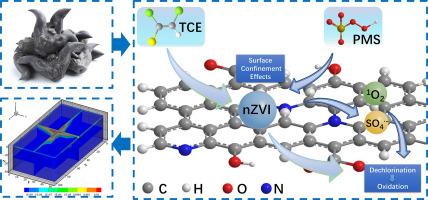N-doping biochar supported zero-valent iron for the activation of peroxymonosulfate to remove trichloroethylene in groundwater: Surface confinement effects and application efficiency
IF 6.3
3区 工程技术
Q1 ENGINEERING, CHEMICAL
Journal of the Taiwan Institute of Chemical Engineers
Pub Date : 2025-08-23
DOI:10.1016/j.jtice.2025.106362
引用次数: 0
Abstract
Background
The application of TCE posed significant challenges for groundwater remediation. Current remediation strategies, including advanced oxidation processes (AOPs), face challenges such as low catalytic efficiency, interference from natural organic matter (NOM), and scalability limitations.
Methods
This study systematically investigated the innovative application of an N-doped biochar-supported zero-valent iron (BC-nZVI) composite for the activation of peroxymonosulfate (PMS) to remove trichloroethylene (TCE). The BC-nZVI/PMS system provided an understanding of the synergistic adsorption and catalytic mechanisms.
Significant
It achieved complete TCE degradation within 60 min, exhibiting enhanced catalytic efficiency and remarkable stability over five consecutive cycles. Molecular electrostatic potential (ESP) analysis and adsorption energy calculations indicated that N-doping sites and nZVI sites significantly enhanced PMS and TCE adsorption, creating surface confinement effects that facilitated the catalytic process. Moreover, the system effectively mitigated the impact of natural organic matter (NOM) on TCE removal. Further analysis confirmed the efficient generation of reactive oxygen species responsible for TCE degradation. The bench-scale experiment and multiphase numerical simulation model highlighted the potential for large-scale application of the system in groundwater treatment.

n掺杂生物炭负载零价铁活化过氧单硫酸盐去除地下水中的三氯乙烯:表面约束效果和应用效率
TCE的应用对地下水修复提出了重大挑战。目前的修复策略,包括高级氧化工艺(AOPs),面临着催化效率低、天然有机物(NOM)干扰和可扩展性限制等挑战。方法系统研究了n掺杂生物炭负载零价铁(BC-nZVI)复合材料在过氧单硫酸盐(PMS)活化去除三氯乙烯(TCE)中的创新应用。BC-nZVI/PMS体系提供了对协同吸附和催化机理的理解。在60分钟内完成了TCE的完全降解,在连续五个循环中表现出更高的催化效率和显著的稳定性。分子静电势(ESP)分析和吸附能计算表明,n掺杂位点和nZVI位点显著增强了PMS和TCE的吸附,形成了有利于催化过程的表面约束效应。此外,该系统有效减轻了天然有机质(NOM)对TCE去除的影响。进一步的分析证实了活性氧的有效生成,负责TCE的降解。实验结果和多相数值模拟模型显示了该系统在地下水处理中的大规模应用潜力。
本文章由计算机程序翻译,如有差异,请以英文原文为准。
求助全文
约1分钟内获得全文
求助全文
来源期刊
CiteScore
9.10
自引率
14.00%
发文量
362
审稿时长
35 days
期刊介绍:
Journal of the Taiwan Institute of Chemical Engineers (formerly known as Journal of the Chinese Institute of Chemical Engineers) publishes original works, from fundamental principles to practical applications, in the broad field of chemical engineering with special focus on three aspects: Chemical and Biomolecular Science and Technology, Energy and Environmental Science and Technology, and Materials Science and Technology. Authors should choose for their manuscript an appropriate aspect section and a few related classifications when submitting to the journal online.

 求助内容:
求助内容: 应助结果提醒方式:
应助结果提醒方式:


